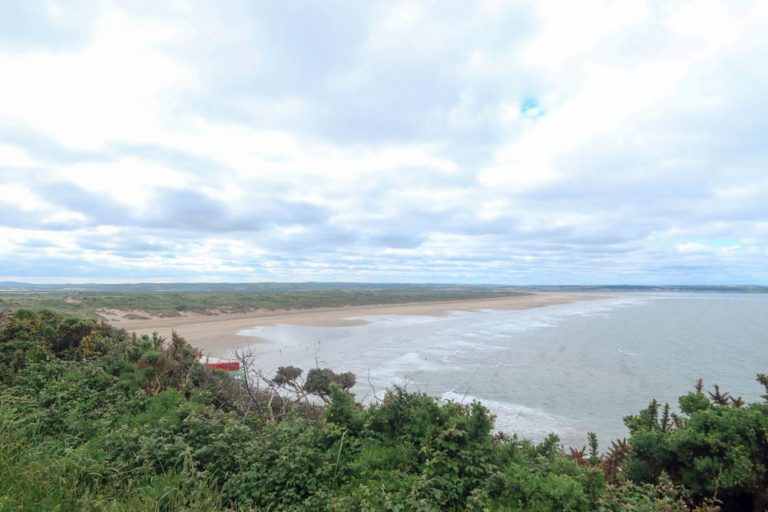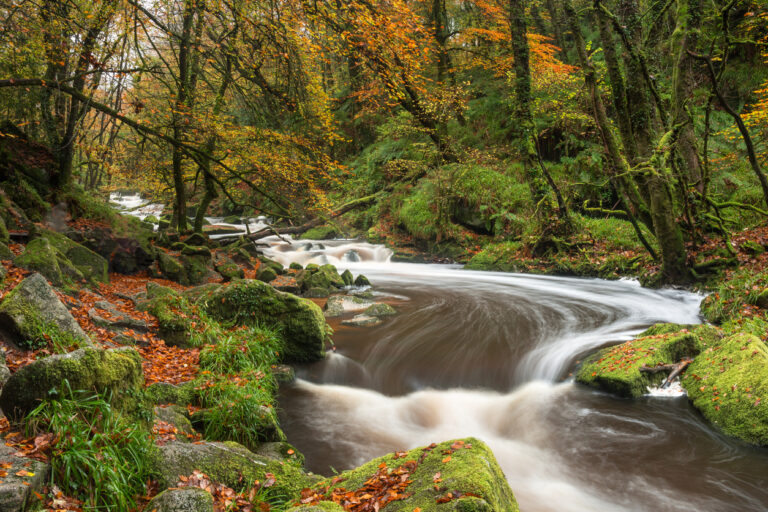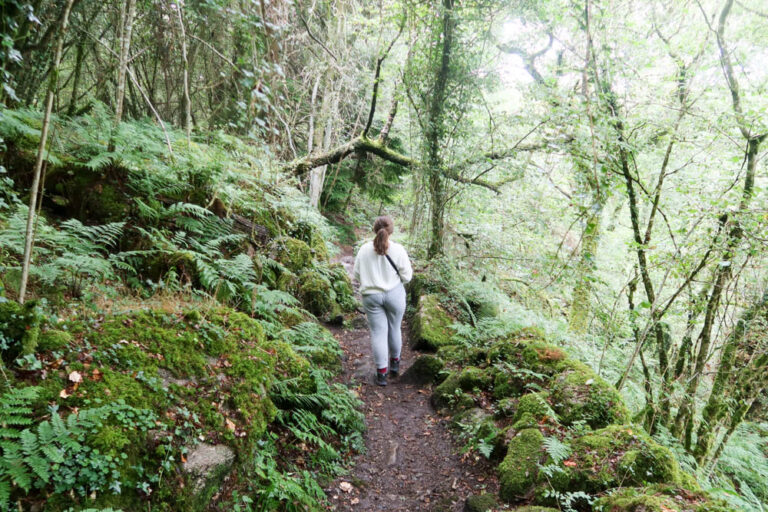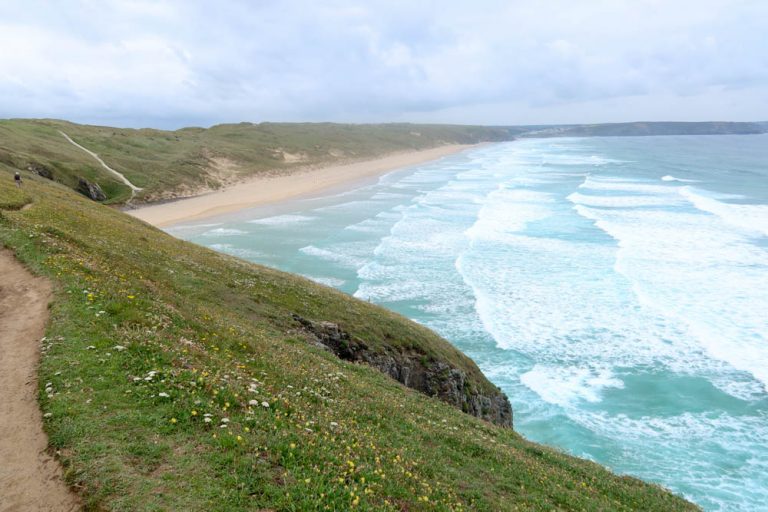How to Visit Exeter Cathedral: Devon’s Ecclesial Heart
Standing proud as a landmark of the city, Exeter Cathedral is one of Devon’s top tourist destinations, and one of the most impressive ecclesial buildings in the country.
Dating back more than a millennium, the Cathedral boasts the longest uninterrupted Medieval gothic vaulting in the world and has been the setting of countless notable events in Exeter’s fascinating history.
This guide will take you through all of the best things to see at Exeter Cathedral and give you an overview of the building before your visit!
Exeter Cathedral History
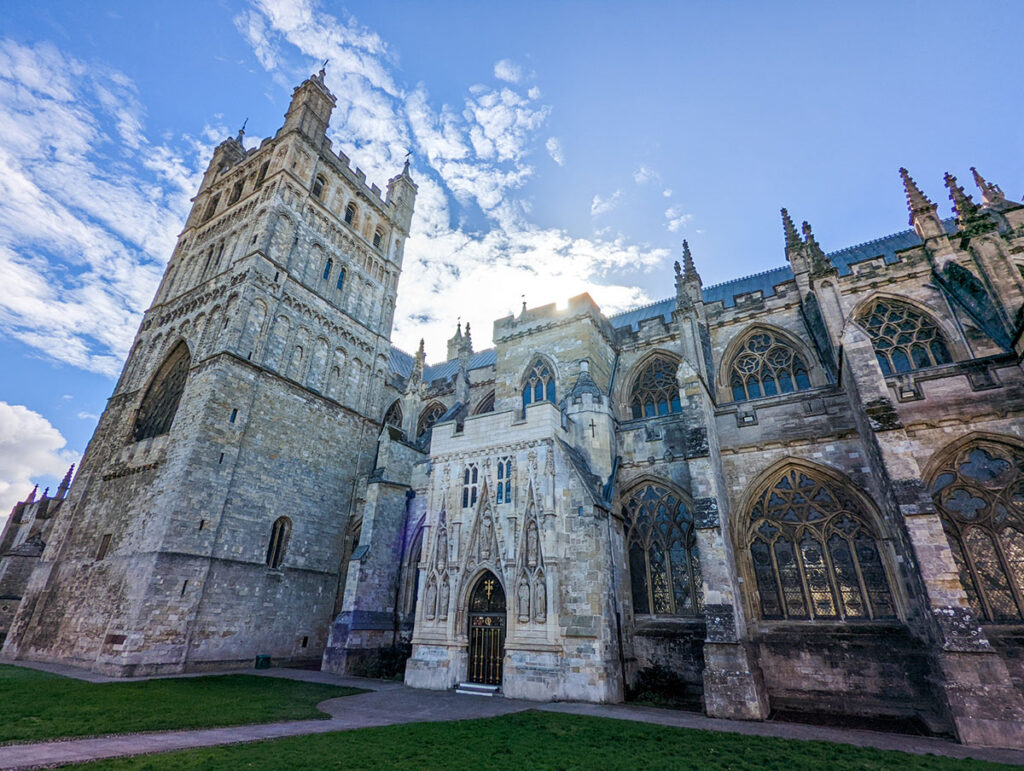
Although the present building that you can see today was completed around 1400, the story of Exeter Cathedral began all the way back in the 7th century, when the first place of worship was constructed.
In 1050, the first cathedral was built on the current site. At the time, the seat of the Bishop of Devon and Cornwall was based in Crediton but was transferred to Exeter.
The first cathedral was Norman, and while most of it has been remodelled, the two towers remain from this period.
In 1107, the church’s remodeling began. This was completed in the latter part of the 12th century, but by 1258, the cathedral was considered outdated and old-fashioned.
The Bishop at the time travelled to Salisbury to see their new cathedral, and quite literally got Cathedral envy, so decided to completely remodel Exeter Cathedral again in the Decorated Gothic Style!
So, around the mid-13th century, the Cathedral that we see today started to be built. It was made of local stone and took around 150 years.
Due to this, you can see many different styles of sculptures, particularly on the front wall.
A tour guide once told me that there are such vastly different sculptures in some places because the sculptors kept dying of the Black Death!
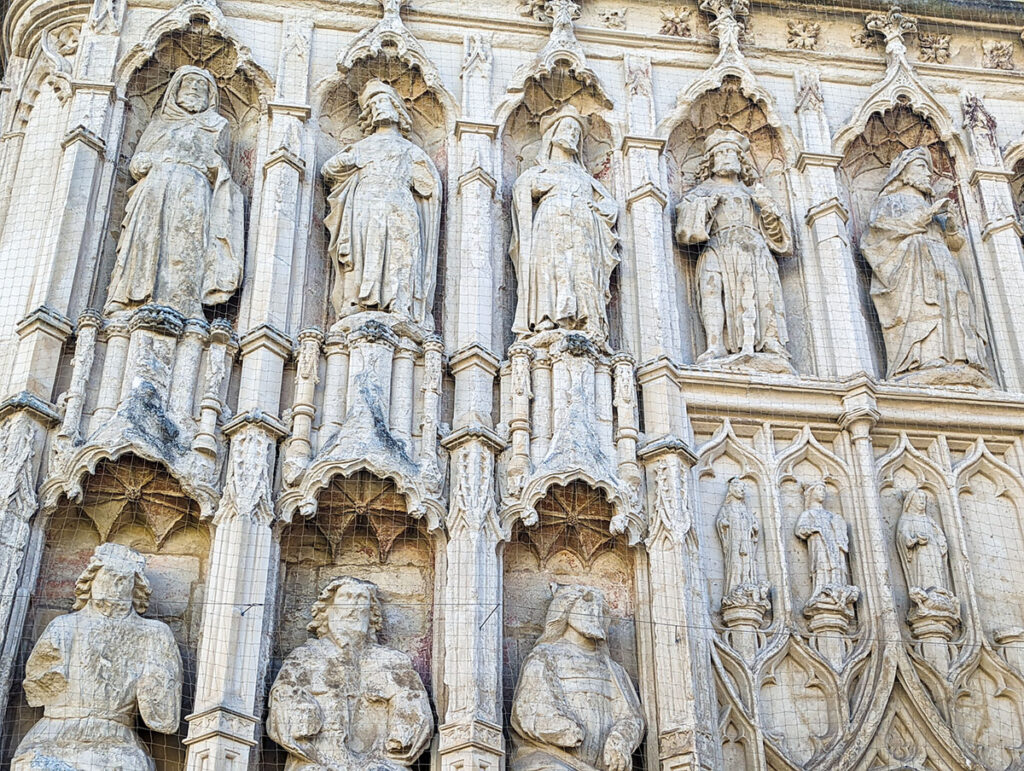
Finally, the cathedral was completed at the turn of the 15th century.
But it wouldn’t be long before another challenge posed itself – the Dissolution of the Monasteries.
As the cathedral wasn’t a monastic building, it wasn’t completely destroyed, but just disused somewhat.
The cloisters were destroyed in the Civil War, but the Cathedral was restored and regained its grandeur in the 17th century and throughout the Victorian period.
During World War Two, Exeter was targeted due to its historical heritage (it was part of the Baedecker Blitz, where Hitler used a German guidebook to locate culturally important UK cities).
Remarkably, the Cathedral was relatively unscathed throughout the war – a bomb landed directly on the Chapel of St James and destroyed it, and a Medieval screen shattered (and has since been repaired), but the rest of the building remained intact.
If you see photos from the destruction of Exeter in other parts of the city, the preservation of the Cathedral was remarkable.
Post-war, Exeter Cathedral retained its prestige as an ecclesial centre, and nowadays hosts various services throughout the year.
As it’s one of the most magnificent cathedrals in the country, it’s also a popular tourist destination with both domestic and international guests.
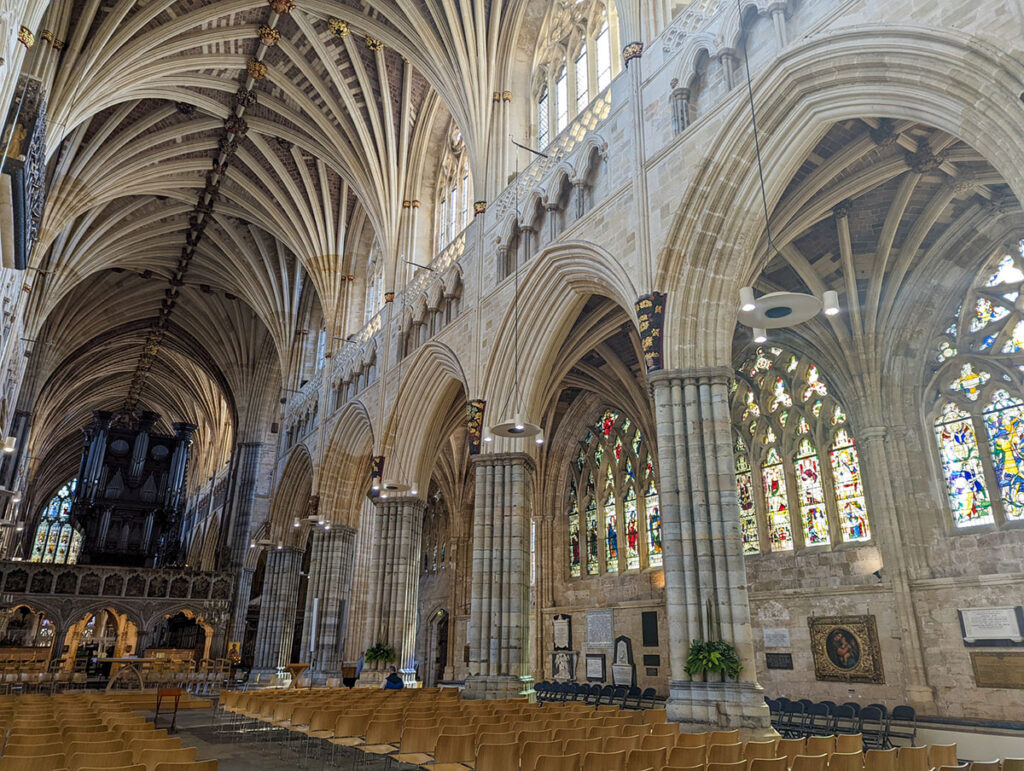
There’s a small charge to enter the cathedral to help its preservation and ensure that it remains a landmark of Exeter City for future generations to enjoy.
Things to see at Exeter Cathedral
There’s plenty to admire at Exeter Cathedral.
You’ll be wowed by its amazing architecture from the outside and find hidden histories inside.
Here are a few things to look out for while you’re exploring.
Outside the Cathedral
Begin your Exeter Cathedral tour outside. Here are some things to see:
Grotesques
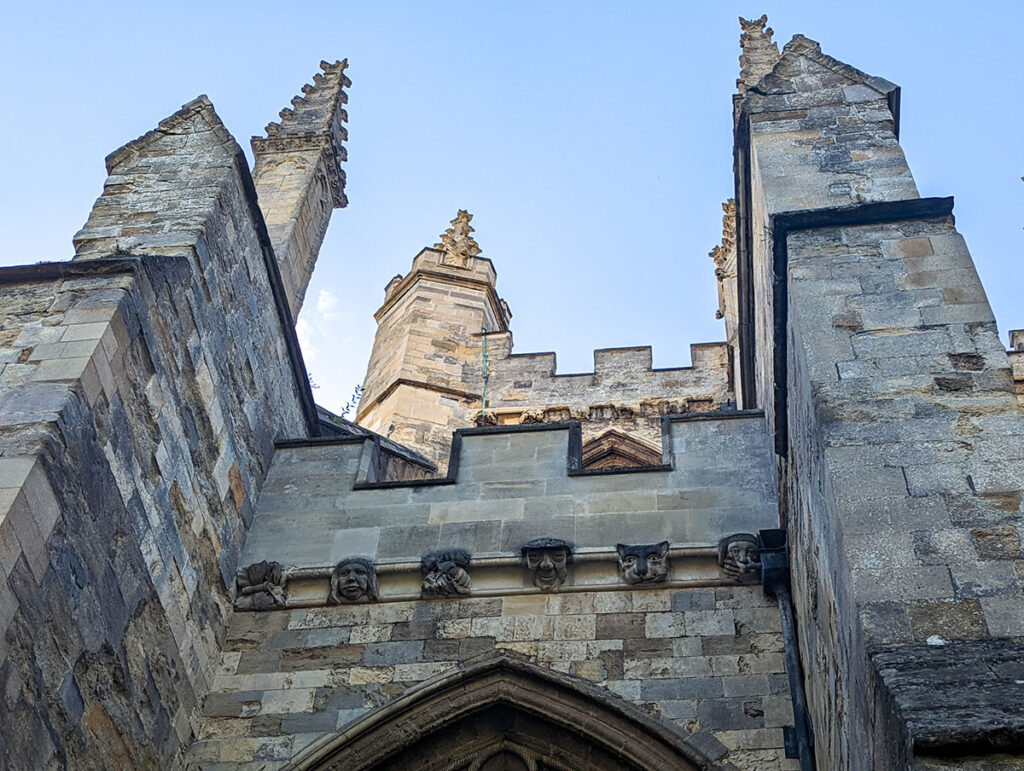
Grotesques are similar to gargoyles, but they don’t spit water.
There are lots of grotesques all over Exeter Cathedral – some that were carved as inside jokes!
Some of my favourite are located on the left side of the Cathedral facing Cathedral Green.
There’s a row of grotesques here including a dog smoking a pipe and the architect at the end who is laughing at his work!
Norman towers
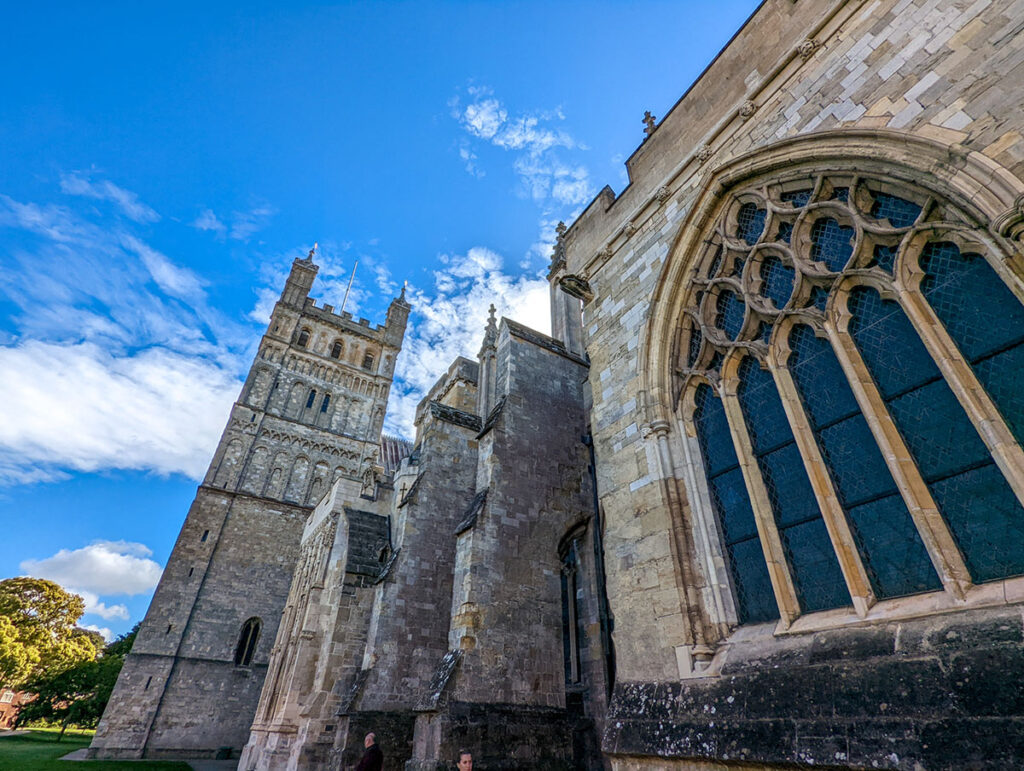
The two towers on either side of the Cathedral are Norman, dating back to the building’s conception.
If you look at them from the outside, it’s quite clear that they’re of a different architectural style to the rest of the building!
West Front Image Screen
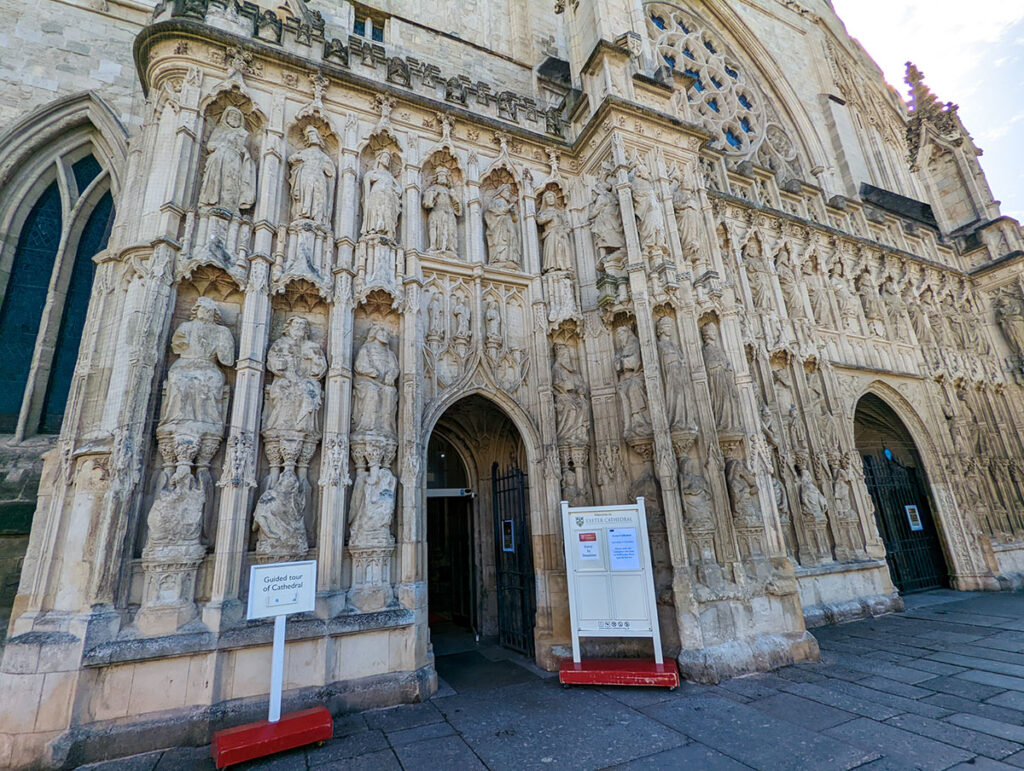
Exeter Cathedral’s West Front Image Screen is the official name for the front of the cathedral.
Dating back to around 1340, the screen is dominated by carvings of different statues, all representing different figures, including Kings of Judah, Apostles, Evangelists, Old Testament Prophets, and God.
There used to be a figure of the Blessed Virgin Mary (to the right of God), which was demolished during the Reformation. It was then replaced with a statue of King Richard II, which sits there today.
The image screen used to be completely coloured, as many cathedrals were at the time.
Over time, due to washing and the weather, the colour chipped away, and nowadays only very little is visible if you look closely.
Inside the cathedral
There are plenty of aesthetic features to admire inside the cathedral, although it’s also worth taking some time to learn about their spiritual heritage.
In particular, look out for the following:
Vaulting
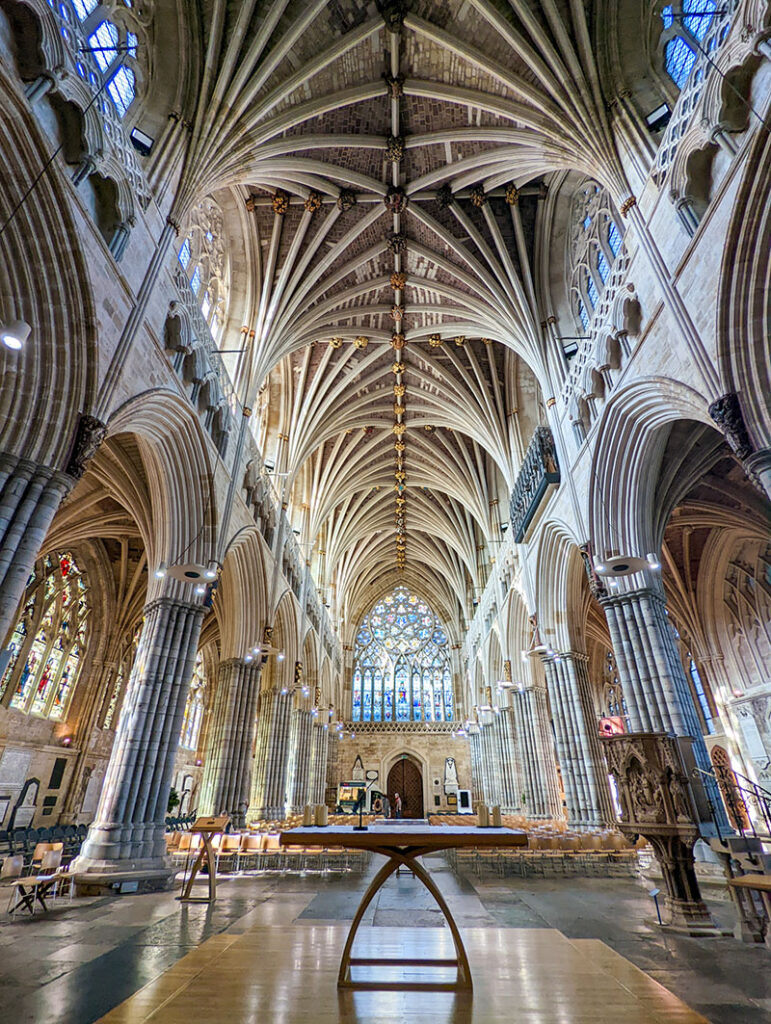
The Cathedral vaulting is definitely one of its best features.
It’s the longest uninterrupted Medieval Gothic vaulting in the world, thanks to the fact that the cathedral has no middle tower.
It’s incredibly striking when you walk in, offering a great perspective to any photographs.
Minstrels’ gallery
Dating back to the 14th century, the Minstrel’s Gallery is a small indoor balcony that was perhaps used for musicians.
It’s engraved with figures of angels playing Medieval instruments.
Great East Window
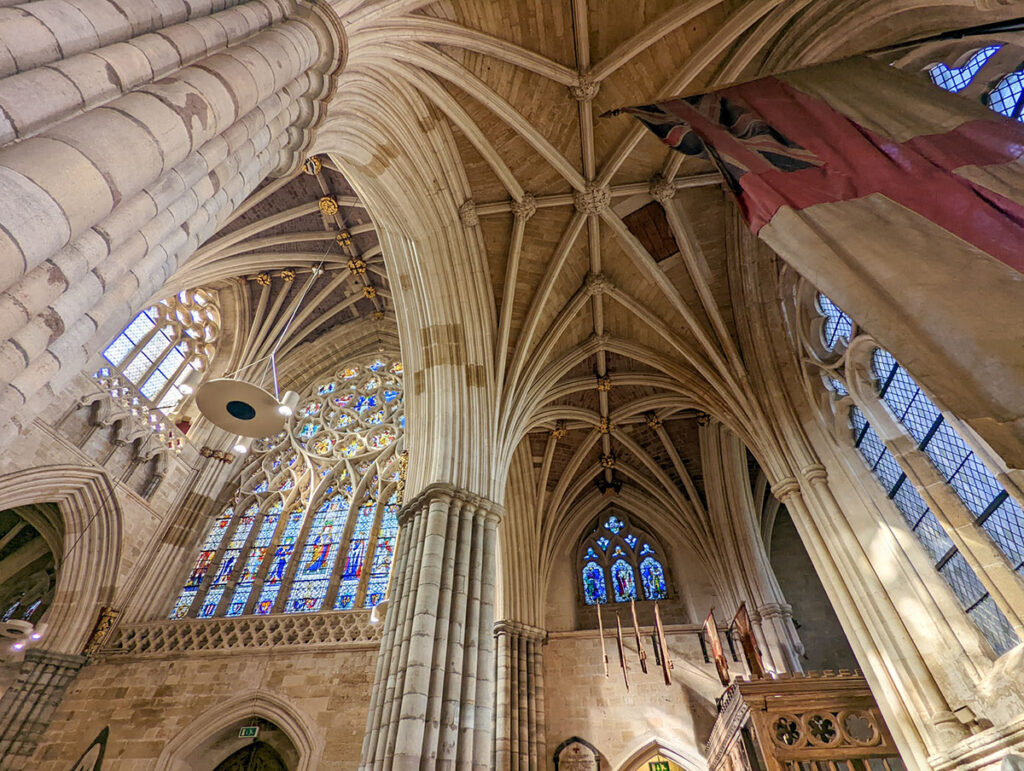
Another highlight of Exeter Cathedral is the Great East Window, which is made from stained glass.
It depicts various figures, most of which date back to the early 14th century.
In World War Two, the glass was removed and stored safely to ensure that it wasn’t destroyed.
It’s a good thing that it was – nearly all the glass that remained in Exeter Cathedral was destroyed in the Exeter Blitz.
Astronomical clock

The Astronomical Clock depicts the solar system – or at least, a Medieval interpretation of it!
There’s also a dial that shows minutes, so you can tell the time on it.
There’s a small chime every quarter of the hour from this clock.
Bishop’s Throne
The Bishop’s Throne dates back to the early 14th century and is made entirely of Devon Oak, and has been the seat of countless bishops through the ages!
Like the Great East Window, the throne was dismantled and removed from the cathedral during WW2.
St James Chapel
St James Chapel was the main part of Exeter Cathedral that was destroyed in WW2.
It was hit by a bomb on 4th May 1942 and was rebuilt post-war – it’s largely a reconstruction of what was destroyed but also has some features from the 20th century.
In the chapel, there’s a memorial to Polish airmen who operated in the city during the war and countered some of the attacks.
The Chapel of Our Lady
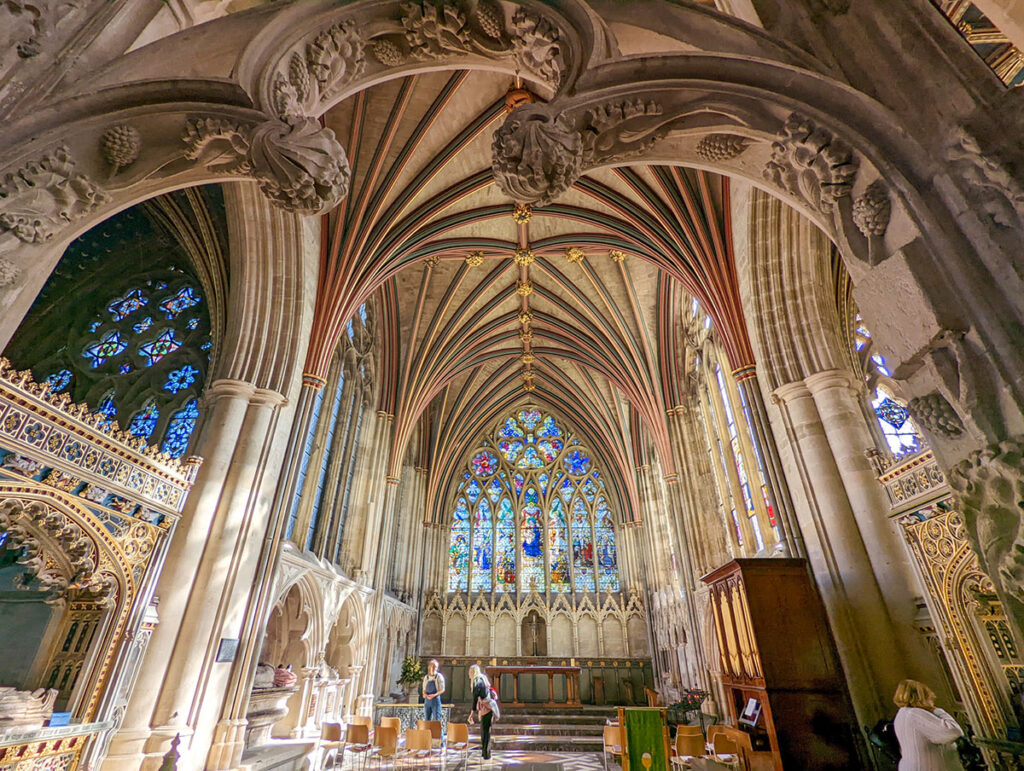
The Chapel of Our Lady is one of my favourite parts of Exeter Cathedral.
With a stained glass window at the back and ornate carvings on the archways, it boasts some of the most stunning architecture in the whole building.
It’s a place for quiet contemplation, and I always feel immediately at ease whenever I step in.
Roof tours

At various points of the year, you can explore the tower roof with a full roof tour.
This is an incredible behind-the-scenes experience above the nave, where you’ll walk the length of the vaulted ceiling, see the ringing tower, and eventually reach the cathedral roof.
Please note there is an extra cost for this activity.
Cathedral Green
There’s also quite a lot to see around the Cathedral, on the green. Here are some pointers:
Historic buildings of the Cathedral close
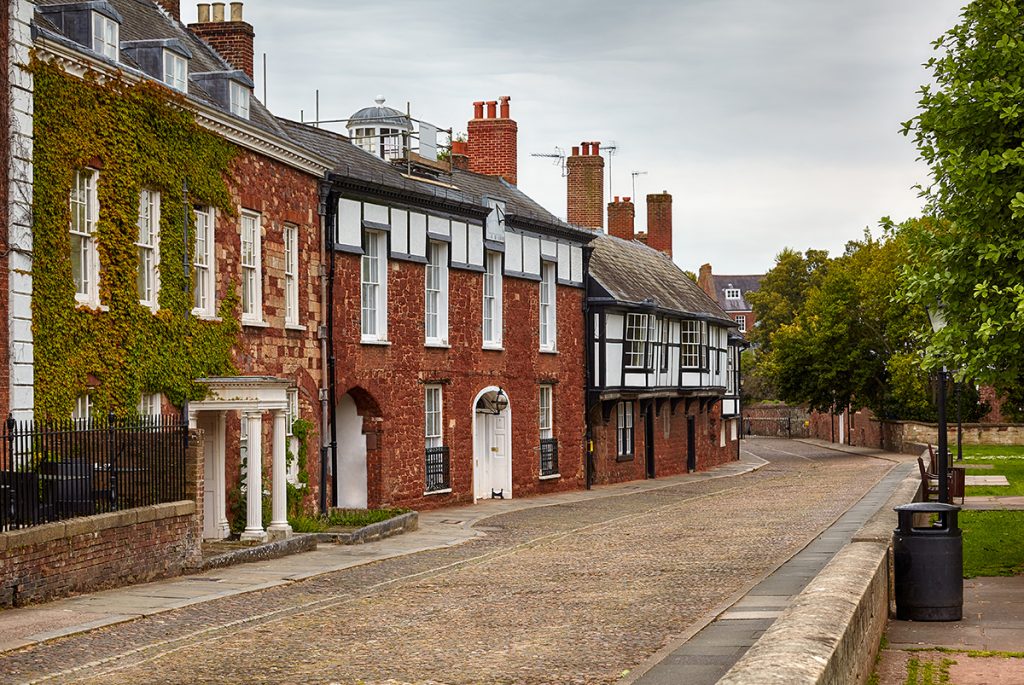
Many of the buildings of Cathedral Close are Medieval and survived the Blitz.
Nowadays, they accommodate shops and cafes, but there’s plenty of beautiful architecture to enjoy!
If you’re looking for a cup of tea after the cathedral, head to Tea on the Green.
For something stronger, visit The Ship Inn, which has been frequented by both Sir Walter Raleigh and Sir Francis Drake in the past!
City walls
Exeter used to be surrounded by city walls, and you can see them just a short walk from Cathedral Green.
While these were built by the Romans, they were adapted by various other historic groups as late as 18th century.
Also, look out for the touchstone.
This is a slab that people used to touch when they entered the city.
The Medieval thinking was that there was bad omen outside of the city and, if they touched the touchstone, the bad omen from them would be removed!
Red Coat Walking Tours
I’m a big fan of Red Coat Walking Tours.
These are free tours in Exeter, run by volunteers.
They span the city centre, beginning at the statue of Richard Hooker.
Some of the tours, particularly the Cathedral to Quay walking route, encompass Exeter Cathedral and discuss some of its histories.
Markets
There are a few markets on Cathedral Green throughout the year, including Exeter Christmas Market which runs in November and December, and food markets during the summer months.
St Martin’s Church
St Martin’s Church is a small medieval church that’s located around the corner from Exeter Cathedral. It’s a great example of 15th-century architecture and while small, is worth poking your head into!
County of Devon War Memorial
Made from stone from Haytor in Dartmoor, the County of Devon War Memorial commemorates all of the fallen soldiers and other deaths of people from Devon (approximately 11,600) from World War One.
Roman Bathhouse
While you can’t actually see this (it’s literally underneath the green), there is a Roman Bathhouse right here in Exeter!
This part of the city was the centre long before the cathedral was built; in fact, the Romans established the city here, thanks to its advantageous position meaning that they could see for miles.
They built one of their famous bathhouses here, which was excavated in the 1970s.
However, due to not having enough funds, this project was abandoned and the bathhouses were covered again.
Hopefully, in the future, the ruins will be excavated and there will be even more to admire around the cathedral!
Events at Exeter Cathedral
Throughout the year, there’s an exciting range of world-class events at Exeter Cathedral.
These include things like after-hours tours, special concerts, or art exhibitions.
Some of these have an extra charge, whereas others are free of charge.
They vary year on year (and can depend on the time of year!) so I’d recommend checking out Exeter Cathedral’s what’s on page to see the vibrant calendar of events.
Visiting Information
Here’s some information that you might need to visit the cathedral:
Admission price
The modest admission fee for adults is £7.50; those under 18 can see the cathedral free of charge if they’re with an adult.
To obtain entry, just head to the ticket office inside the cathedral, where you can pay by cash or card.
If you live in EX1 – EX4, you can also get free entry with a resident’s card. Admission for carers is also free.
There is no admission fee for worship or prayer.
Opening times
The normal visitor hours are as follows:
- Monday to Saturday: 9am – 5pm
- Sunday: 11:30am – 4pm
Please note that these can vary depending on whether there are any events or services taking place.
Accessiblity
Parts of the cathedral are usually accessible to disabled visitors. The main floor is generally wheelchair-friendly, although some of the ground is uneven. Quire access is available via a ramp.
There are also disabled toilets in the building.
While parking is limited right by the cathedral, drop-offs outside can be arranged.
If you have any questions about accessibility, feel free to contact the cathedral who will be happy to assist.
Parking
The nearest parking is probably the Cathedral and Quay Car Park (Google maps location).
However, I always park at Haven Banks Car Park 2 (Google maps location) and walk from the Quay (about 15-20 minutes) because it has the best rates.
Public transport
The new Exeter Bus and Coach Station (Google maps location) is situated about a 10-minute walk to the cathedral.
Services from all over Devon stop at this bus depot, plus you can also take National Express coaches to London, Bristol, Birmingham, Plymouth and a range of other towns and cities.
The cathedral is a six-minute walk from Exeter Central Station, where you can take trains to Exeter suburbs like Digby and Sowton and Polsoe Bridge, plus services to Exmouth, Dawlish and Paignton.
Exeter St Davids, which is where most cross-country trains stop, is a little further (around a 16 minute walk). You can take trains from Exeter St Davids to Exeter Central to reduce the walk.
Uber operates in Exeter, and Apple Taxis is a reliable firm.
Exeter does have an airport, but it doesn’t fly to many destinations. Train or coach is the best way to access the city.
Where to visit near Exeter Cathedral
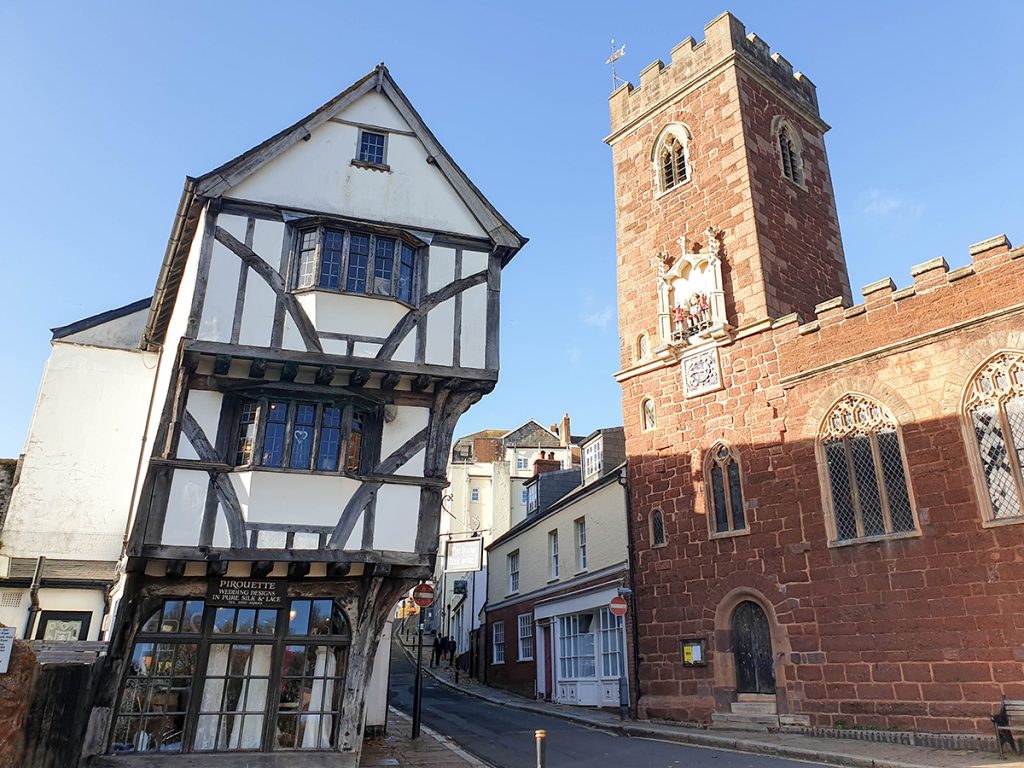
While the cathedral is certainly amongst the best things to do in Exeter, there are plenty of other attractions in the city too. Here are some of my favourites:
- Exeter Tunnels: Spanning underneath the city, you can do a tour of Exeter’s underground passageways to learn more about the city in Medieval times!
- Exeter Quay: This is my favourite part of Exeter. A quay that links to the Exe Estuary, it’s a gorgeous place for a walk, or you can hire bikes or watersports gear from Saddles and Paddles. There are lots of waterside restaurants and pubs too!
- Gandy Street: The most magical street in Exeter, Gandy Street is lined with independent shops and restaurants and it could have been some of the inspiration for Diagon Alley in Harry Potter.
- Parliament Street: A bit more of a niche attraction, but great for those who like the weird and wonderful, Parliament Street is rumoured to be the narrowest street in the world.
- The House That Moved: Another random attraction (but one I love), this house quite literally moved – it was hoisted onto railway tracks when town planners wanted to knock it down to build Exeter’s ring road, and moved to its current location!
- Exeter City Walls: These walls date back to Roman times, marking the historic city boundaries. While you can’t walk on top of them, exploring their perimeter is a must while you’re in town.
- The Royal Albert Memorial Museum: This museum has exhibitions about Exeter, Devon and the country as a whole and it’s completely free to explore!
Exeter is well-known as a Cathedral city, so it’s well worth seeing the jewel in its crown while you’re in Devon.
This landmark is a place of immense spiritual heritage, but it’s also a hub for the city’s community and culture.
This guide should help you explore one of the finest cathedrals in the UK!

